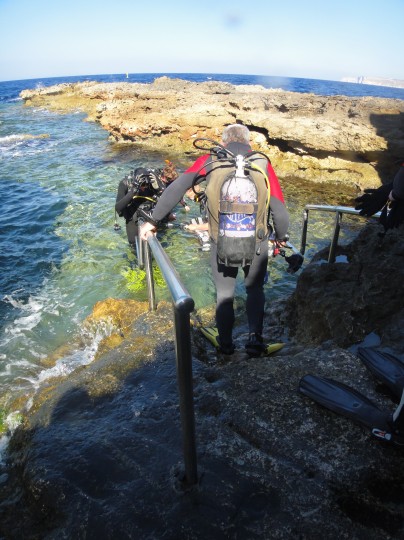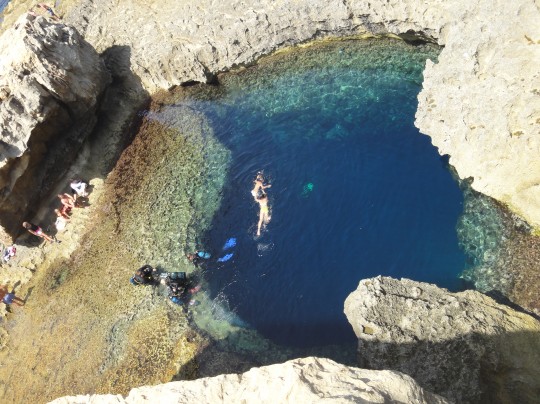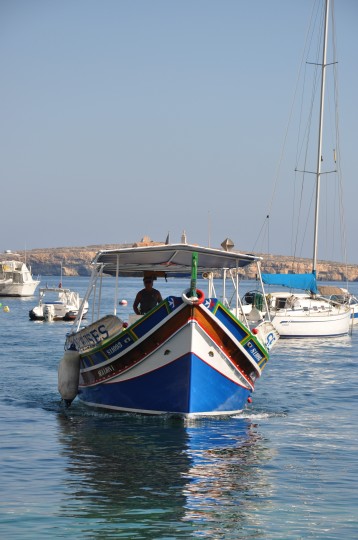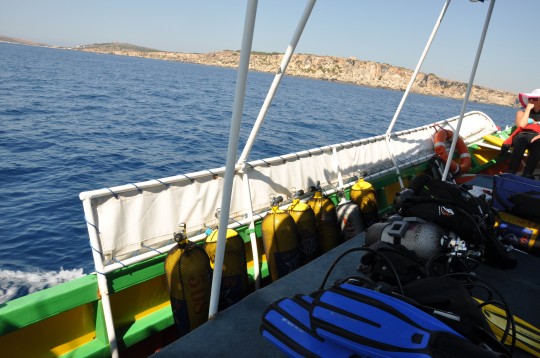
We are just home from an epic dive trip to Malta. Made up of three main islands, Malta, Gozo and Comino, Malta has a population of approximately half a million people and is located south of Sicily in the Mediterranean. The islands are primarily limestone and have very few beaches but instead have stunning cliffs, many small bays and inlets and incredible rock formations eroded by centuries of wave action forming stunning caves, overhangs, swim throughs and some of the best wall diving in the world. In summer the weather is so predictable as to be almost boring… If 32 degrees during the day, 23 degrees at night, and an occasional light breeze can be called boring! There are no tides in Malta and almost no sand (most of the beaches are man-made) which makes for extremely clean water.

As a vacation destination the Maltese islands have a lot more than just diving but diving was our primary focus. As a country it functions reasonably well, has buses that run all the major routes, tourist buses, boat trips, shopping and of course dining and night life. We stayed in a self-catering apartment in the town of Bugibba, and we were 5 minutes’ walk from the bus terminal, the dive centre, the town square and the ocean. The place is vibrant and has something for everyone. We were fortunate to experience a Malta Mini Owners Club event in the town square on one of the evenings.

The Maltese have enjoyed (well, some of them have!) membership to the EU since around 2008 and prices are comparable across Europe for most things and in many cases a bit cheaper than mainland Europe. This trip took us to the Netherlands, Germany, Denmark and Sweden and finally Malta so we had a good idea of costs for basic items. Fuel was most expensive in Denmark at over R18 a litre, cheapest in Malta at R14. Water was most expensive in Germany, with Cape Town International Airport a close second.

Sadly dive gear was cheaper in all these countries than in South Africa and before you jump on the “number of divers” band wagon, Denmark has 5 million people , three to four months of diving a year, and yet sell “Made in sunny South Africa” Bright Weights for 20% less than our local prices. Go figure.
Never mind all of that… Back to the diving!

In Malta we took a ten dive package, including gear and transport to all the dive sites (dives to Gozo and Comino include a ferry trip). We did three dives on Nitrox (an extra R50 per dive) and the cost was R310 per dive including all gear, two of which were boat dives. We were offered the choice of 10, 12 or 15 litre cylinders in steel or aluminium at no extra cost. Of the ten dives, eight were to depths of 30 – 37 metres and the dive at L’Ahrax Point was around 14 metres. Dive times were 40 minutes to an hour, because the ascent was usually done along a wall, very slowly, and the warm water and virtual absence of currents made for excellent air consumption. Average visibility was around 30 metres and the water temperature was 26 degrees with the coldest dropping to 18 degrees inside some of the wrecks.

The shore dives are like nothing I have ever experienced. Several of the sites start with a giant stride – and I mean GIANT stride from a jetty 2.5 metres above the water. Descending to 5 metres you then you swim a distance of around 10 -20 metres, over a shallow ledge at about 10 metres, and then the sea floor just drops of to in some places 40 metres. You descend to around 15 metres and can clearly see the sand and seagrass below as you swim out to the wrecks, most lying upright in 35-40 metres of water. Within a few minutes the wreck looms ahead and you descend onto the deck or sand if you want to check out the propeller. As you approach deco you ascend to around 20 metres and the start the return leg of the dive, ascending slowly to around 15 metres you reach the wall within 10 minutes, and spend the next 20 odd minutes at 10 metres as you swim slowly back to the entry point. The last 5 minutes of the dive, or longer, air dependent, you cruise around at 5 metres on various ledges doing your safety stops.

We dived three of the wrecks twice, the tug boat Rozi, scuttled in 1992 in 34 metres of water and the P29 patrol boat scuttled in 2007, on the white sand at 38 metres. The Patrol boat, 52 metres long, still has paint showing and was for me one of the best wreck dives I have ever done. Inside the wreck the electrical switch boxes still have labels and the colour of the wiring is still visible.

The largest wreck we dived (also twice due to its length) was the Um El Faroud, scuttled in 1998. This is an oil tanker, 110 metres long and 16 metres wide and lies at 35 metres on the sand. This tanker has its propeller in place and is absolutely massive. We also penetrated this wreck and the interior is still showing paint in some places and many clearly visible and well defined features in the wheel house and engine room.

We also dived a site called the Inland Sea on the island of Gozo, where you enter the water in a 2-3 metre deep harbour, descend to 10 metres and swim through a huge tunnel – quite narrow, with tourist boats above. It is quite spectacular watching them from below zoom in and out of the tunnel. After a relatively long swim along a wall where the top of the ledge is at around 12 metres and the sand below close to 40 metres, you enter a smallish cave at around 18-20 metres depth that leads into a narrow passage. At this point it becomes very dark and you swim into a cave for around 8- 10 metres, this narrows and then becomes a vertical swim up a passage wide enough for one diver at a time opening up into a huge cave at around three metres. Once in this cave you have a short swim and drop down to around 15 metres where it opens up into a stunning crevice that opens up to the deep blue ocean.


Diving Malta gives a whole new meaning to the word shore entry. Being able to reach depths of 40 metres in a matter of minutes, reaching wrecks just as quickly reduces the need for boats dramatically. This does not mean boats are out of the picture as there are many, many more dive sites only reachable by boat so we also tried this out. We spent one of the days diving from a boat. The boat was a traditional Maltese boat and picked us up at a jetty in a small harbour near our apartment. The boat has inboard diesels and sails at around 4-5 knots. A giant stride is required for entry off the boat, and a ladder dropped over the side at the end of the dive makes exiting the water a piece of cake. Once on board you sit down and then remove your gear. A slow leisurely pace makes the day on the boat a pleasure and the boat has a covered deck keeping the sun at bay.

In total we estimate there must be around 40 dive centres in Malta, there were three within 100 metres of the dive centre we used. Clare took photos of every vehicle we saw at the dive sites and every day there were several new names in the parking lot. We also visited every one we walked by. The Maltese government encourages diving tourism, regularly scuttling ships close to shore, and the industry is well-regulated.

The centre we used was Subway Scuba, a Russian-owned and run centre with a Russian and a Maltese resident Instructor. The guided dives are all done by Instructors in Malta and not Divemasters. Most centres had several language options listed on their windows, a must in such a tourist destination. The centre was well run, very efficient and we left on time every single day, reaching the dive sites first and ensuring the best spot close to the entry points. (Some sites are on very steep inclines and being there first ensures an easy day’s diving.) We were issued with gear on day one and given a box to store it in. Each day your box, labelled with your name was loaded onto or into the vehicles and off you went. The Nitrox mix was on the money every time and there was not a single delay on any of the dives. Perhaps just one funny moment when the scuba bus refused to start in the hold of the car ferry from Gozo and we had to push it… Hilarious for us but embarrassing for the driver!


Watch this space for more pictures and reports on the dives we did in Malta… It was some of the best diving I’ve ever done.
















